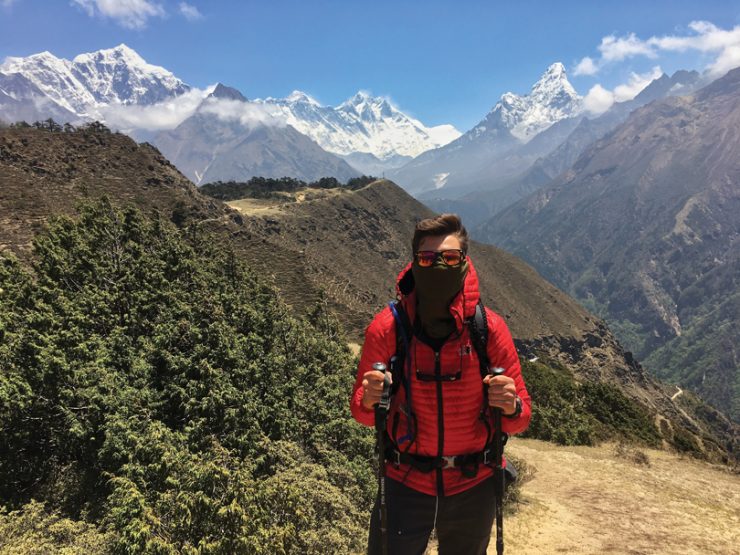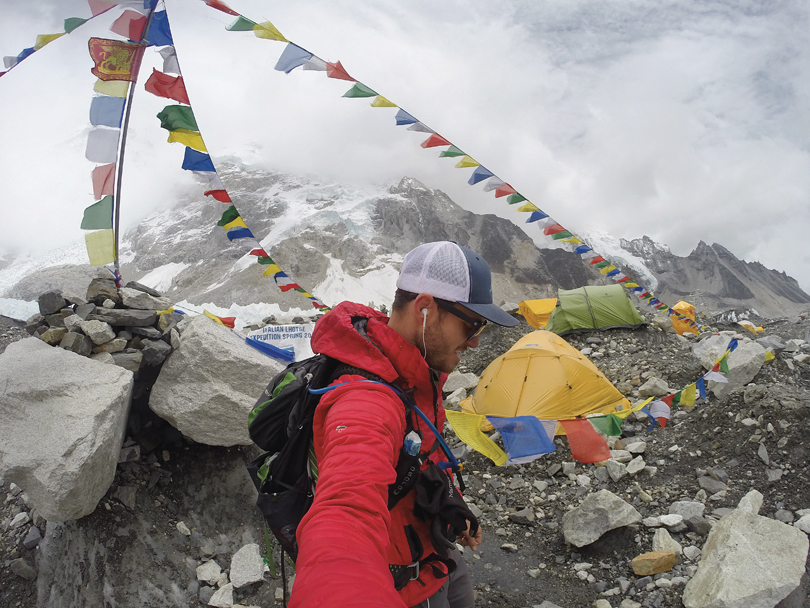Thoughts racing, pulse pounding, Brandon Arant (BS ’13) watched the credits of a movie flurry by like flakes of snow in a blizzard. The year was 2015, and the film was Everest—a biopic adapted from the memoirs of Beck Weathers, survivor of the 1996 Mount Everest disaster. The movie isn’t a pleasant one. Nor, for that matter, is the story it’s based on.
In real life, Weathers lost his nose, his right arm, all five fingers on his left hand and parts of his feet for a chance to see Everest up close. Sitting in the still-dark theater, Arant took all of this in, thinking, hoping, dreaming.
There would be snow in his future.
Just maybe not as much.
A Man Obsessed
Arant isn’t the sort of person to let opportunities pass him by. That’s apparent, even after just one look at his social media accounts. Vistas of mountaintops and waterfalls, of foreign sunsets and far-flung beaches litter his various feeds — each one a reminder of a different trip, most of which would make the average traveler positively green with envy. Being a talented photographer helps. Even by the unrealistic standards set by diehard Instagrammers, his photos are stunning. But it’s the experiences, not the filters, that draw people to ask, “Where are you going next?”
At the age of 29, it’s safe to say that Brandon Arant has lived.
So, the fact that he would hike Everest was a foregone conclusion. From the moment he first witnessed the mountain’s glacial majesty depicted on screen, he knew he’d have to tackle the beast, Sagarmatha (literally “Sky Head,” the Nepalese name for Mount Everest), head on. Unlike Weathers, though, he would not chase the summit. The risk was too great; the reward, too costly. After watching eight men and women suffer or die on the silver screen, he was in no hurry to join them. It wasn’t fear. Just rational thought.
“It’s too dangerous,” he said. “I don’t think I could put my family through that.”
So instead, he set his sights on something a little more manageable.
Located more than 17,000 feet above sea level, the South Everest Base Camp sits near Nepal’s northeastern border with Tibet. Situated in a narrow strip of land aptly named the Sagarmatha Zone, the camp sees some 40,000 visitors per year. Climbers fly into the base camp’s small staging area from Kathmandu, Nepal’s capital. From there, they journey to the base camp itself.
The trip takes roughly a week by foot in temperatures ranging from the high 20s (Fahrenheit) to -30.
With that in mind, Arant began planning. He read books by and about hikers and their various expeditions. He listened to hiking podcasts, watched hiking videos, went on more than a few hikes himself. Along the way, he spoke with everyone he could think of who might be interested in joining him. Two of the people he contacted were Dr. Brandon Cromer, assistant professor of biology, and Dr. Faith Wiley, a biology lecturer. Arant’s first trip out of the country, a study abroad trip to Peru, had been guided by Cromer a few years before. Cromer and Wiley had also been considering a run at the mountain, and so together with another of Arant’s friends, the group set out for Nepal.
Everyday Dangers
Climbing any portion of Everest is no easy feat. The mountain is unforgiving. Even the relatively “gentle” trek to the base camp proves too much for some, so to prepare, Arant began a series of endurance training workouts. Loading his pack with 40 pounds of extra weight, he’d go to his former high school. There, racing up and down flights of stairs, he forced his legs — and more importantly his knees — to grow used to the strain of near constant upward movement. Two months and 2,000 sets later, he was nearly ready.
In Nepal, he tried to keep things a little more relaxed. He’d left four days for himself at the beginning of the trip. Four days to breathe, to sightsee, to gather the rest of his supplies. He still trained. But he kept it light.
“One day, we just ran through the streets of Kathmandu,” he said. “We tried not to think too much about it.”
The real Everest trip began on the fifth day.
Tenzing-Hillary Airport, also known as Lukla Airport, is served by a few local and international airlines. Many of these employ some of the world’s most talented airmen. These pilots, carefully trained to navigate the frigid skies and perilous peaks of the Himalayan range, take their work deadly seriously. That doesn’t make every trip a joy ride, though. Far from it, in fact.
The airport in Lukla is little more than a single landing strip. It has no obvious runway lighting, little to no electricity, and houses no on-site air traffic controllers. At its widest point, it measures roughly the distance between two bases on a baseball field. It also sits at an 11.7 percent gradient, meaning weary pilots not only have to land a tiny plane on the side of a mountain, they also have to do it going uphill on a runway scarcely the length of five football fields.
For pilots, every landing is a potential death sentence. For visitors, it’s just the beginning.
“We were in such a tiny plane,” Arant recalled, laughing. “You could feel the turbulence the whole way there, just shaking this tiny plane apart. I literally got out, hugged my friend and kissed the ground.”
Safely on the ground, he and his travel companions made their way to a small, local café. There, they met their Sherpas — experienced local guides tasked with ferrying hikers up the mountain — and the porters who would help to carry their equipment. There was no discussion of danger, no ominous tension. Nothing one would expect to see in an adventure thriller.
Instead, Arant said, the Sherpas simply got to work.
“They don’t really bother telling you how dangerous it is,” Arant said. “You’re already there. You can’t really turn around at that point.”
While not quite as brutal as the ascent to the summit, the trek to the base camp presents its own unique challenges. Even at the airport, some 8,000 feet below, climbers get their first taste of trouble. Altitude sickness is a very real threat. The air thins, growing colder. Breathing becomes more difficult. Gradually, climbers start to develop a nagging headache, followed by fatigue and, in the worst circumstances, moderate to severe nausea. The “mountain hangover,” some call it. In this respect, the usually affable Sherpas become tyrants; when the hikers in their care begin to show symptoms, they forbid further travel up the mountain. Inexperienced climbers can, and often do, die from complications relating to altitude sickness.
Higher up, there are more than enough corpses to prove it.
Three members of Asrant’s Everest group (a larger group he and his companions joined after reaching Lukla) had to be airlifted down. They’d fallen ill in the first few days, showing the typical “hangover” symptoms.
Once or twice on the way up, Arant said, he too felt some of the symptoms.
“I woke up with a headache in the mornings,” he said. “I couldn’t sleep on the first night. I got up at 3 in the morning and just waited there, trying to stay warm.”
Everyone there, he imagined, felt something similar. Certainly everyone was tired. The average day’s hike lasted about eight hours, interspersed with occasional visits to small mountain towns along the way. By day four of constant walking, spirits weren’t just falling. They were tanking. It was plainly visible, in his companions’ faces, in the length of their strides, in every outward way. But no one would say it. No one would make it real.
“We’d come that far, you know,” Arant said. “No one wanted to admit they wanted to stop.”
Far from the falling rocks and avalanches shown in movies and thriller novels, the real danger at Everest isn’t the extraordinary. It’s the mundane. The flight in, the trek to the “starting line,” breathing — the everyday dangers that everyone faces are what do the most harm. They’re also the things most neglected by the overly ambitious. Everest, Arant well knows, is no friend to those who don’t know their own limits.
The View From On High
For Arant and his team, the base camp may as well have been the summit. It’s already at a higher elevation than most of the world’s mountains. Only two in North America reach further, both located in Alaska. Neither holds the same prestige.
And the view?
“I don’t even have words for it,” Arant said. “Just the feeling of being there, of seeing everything. It’s incredible.”
The base camp itself isn’t much to look at. Far from being on some remote glacier, it’s little more than a rocky outcropping, sparse and gray. The snow touches here, as it does most everywhere else on Everest, but it isn’t quite the same body-snatching powder one finds closer to the summit. All about the camp, hanging from what look like simple clotheslines, multiolored flags blow in the breeze, placed there over the course of generations by hikers and climbers, scientists and sightseers. It’s beautiful, in its own way. The real payoff, though, is the chance to see the Himalayas as the angels do. From the base camp, one gets an unparalleled view of some of the planet’s purest, most untouched terrain. It’s a surreal sight, even before you realize you might be seeing it from inside a passing cloud.
Needless to say, Arant and his crew were elated. After they stopped long enough to take it all in and snap a few quick photos, though, that elation quickly turned to dread.
“We started thinking, ‘Well, now we’ve got to get back down the mountain,’” he said.
As is often the case, going down was easier than going up. But only just. The trip back to Lukla was slated to take four days at the same eight-hour pace. The group cut it down to three.
Sleeping in a real bed was part of the motivation. Wi-Fi was the rest.
“We were actually supposed to stop in one town, but the next town was about two hours away and it had Wi-Fi,” Arant said. “I said let’s just keep going. We put in 10 hours that day.”
On the trip back down, conversation was scarce. More than once, Arant said, he put in headphones, listening to music or a podcast to focus his mind. An avid social media user, he stressed the importance of “disconnecting” on the journey up. No one wants to, or rather, no one should want to climb Everest for a new Facebook cover photo. Instead, he said, in those moments it’s best to see the world for what it is rather than take it in through a screen. After more than a week of grueling physical exercise, though, he was ready to get connected again. But those connections sometimes bring bad news.
On the way back to Lukla, he learned that their pilot — the one they’d flown into Lukla with — had died in a crash only days before. Arant said he was shaken, but that he was left with no other choice. The only reasonable way to get back to Kathmandu from Lukla is to fly, even if it is terrifying.
“I’ve never had trouble with flying before,” he said, “but it was hard to get back on the plane after that.”
After Kathmandu, Arant and his crew set out for the rest of their journey throughout Southeast Asia. He stopped in Thailand and Bali before spending a few days in and departing from Tokyo, Japan. Each was a worthy enough trip on its own, but the memory of Everest eclipsed them all. For Arant, those few moments on
that rocky outcropping in the Himalayas are, and always will be, a living reminder. Another couple of moments spent living life to the fullest.
Now at home, Arant said he’s enjoying spending time with friends and family. He hopes to enroll in the Master of Physician Assistant Program at Augusta University in the near future, taking the next step toward realizing another of his passions — studying pathology and keeping people healthy. He also plans to return to Nepal in the future to tackle the Annapurna Circuit, a trek of varying lengths (100 to 140 miles, depending on the route) that circles the vast Annapurna Range.
Today, he’s resting.
But tomorrow, there’s no telling where life will take him.







